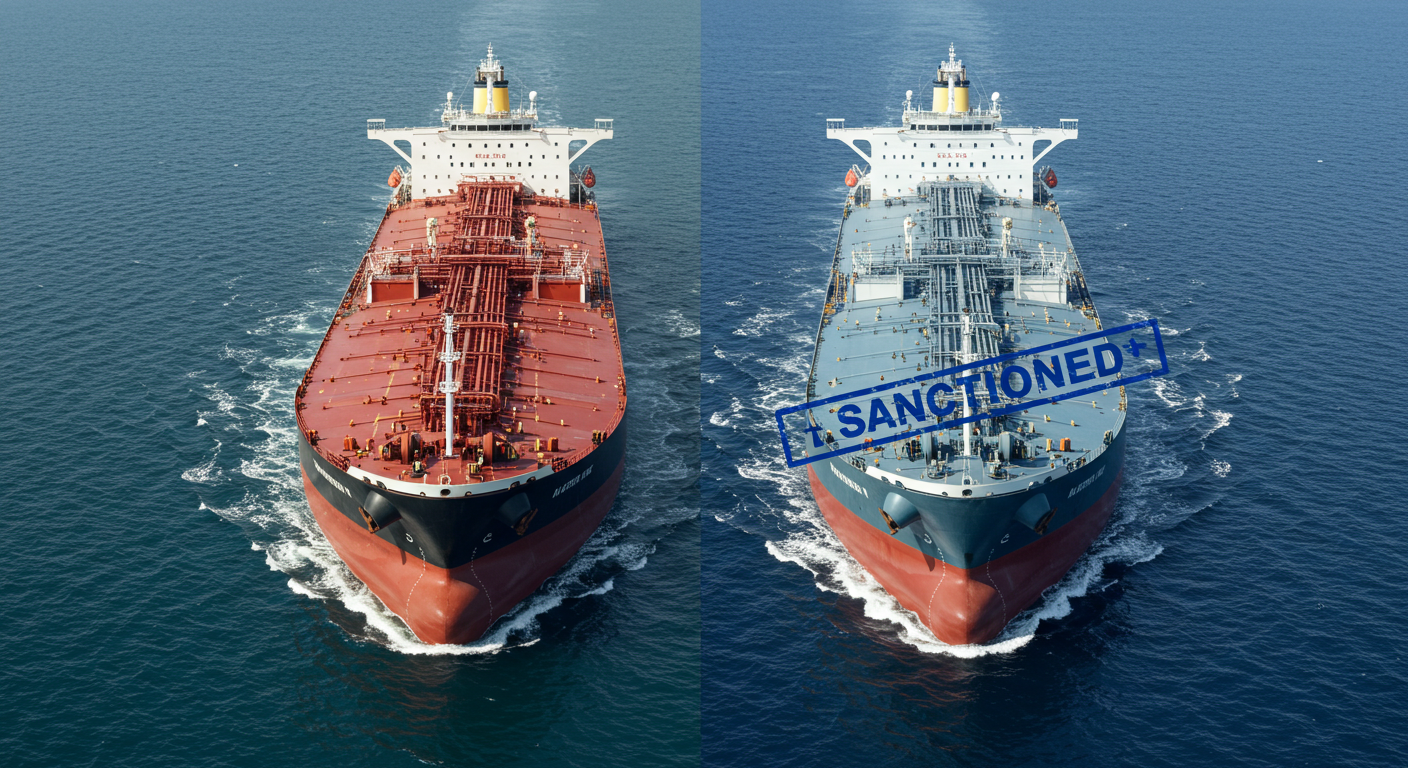At first glance, shipping cargo from Point A to Point B seems straightforward. But beneath the surface, the maritime world is one of the most opaque, fragmented, and high-risk industries there is.

In this environment, failing to detect links to sanctioned entities, jurisdictions, or deceptive practices—such as illicit ship-to-ship (STS) transfers, AIS manipulation, or flag-hopping—can expose the companies shipping the cargo to regulatory, financial, and reputational risk.
Due to rapidly shifting geopolitics, the stakes for maritime sanctions compliance have never been higher. Governments are expanding sanctions regimes targeting:
• Russian crude exports (price caps and export controls)
• Iranian and Venezuelan oil (longstanding embargoes)
• Entities and vessels aiding sanctioned regimes (secondary sanctions)
The U.S.A, EU, and UK have all expanded maritime sanctions in 2025, with measures targeting not only the cargo but also the financing, refining, and logistical support behind illicit shipments.
Compliance challenges are further complicated by the unprecedented growth of the shadow fleet—a network of tankers operating outside normal transparency standards to transport sanctioned oil.
Chartering vessels linked to sanctioned entities
Example: Failing to identify ownership ties to a sanctioned company or individual.
Using ships involved in "dark activity"
Example: Employing vessels that disable AIS (Automatic Identification System) to hide illegal transshipments or routes.
Inadequate due diligence processes
Example: Relying on outdated or incomplete data during vetting, missing red flags related to past sanctions violations.
Our platform mitigates risk against sanctioned entities or deceptive tankers that could slip through the cracks—helping you stay compliant, protect your reputation, and avoid costly missteps.
Shipvet’s sanctions screening service draws from a comprehensive set of data sources, updated daily, to provide accurate and timely compliance checks. The screening includes:
Cross-referencing vessels and related entities against up-to-date global and regional sanctions databases.
Covers all levels of ownership including beneficial owners, operators, managers, and ultimate parent companies, helping identify indirect sanction exposure.
Monitors vessel port calls to or from sanctioned countries, enabling route-based compliance screening.
Tracks the current and historical flag registries of vessels to identify associations with high-risk or sanctioned flags.
Flags instances where a vessel’s AIS (Automatic Identification System) transmissions are turned off or missing, potentially indicating attempts to avoid detection.
Identifies STS activities involving sanctioned or high-risk vessels, including location and counterpart analysis.
Let’s look at real-world enforcement cases that underscore the true cost of compliance failures:
In July 2025 Lloyds’s List reported the case of Vitol seeking the arrest of VLGC Tinos I after it was detained on its maiden voyage to Houston in June 2024 and subsequently sanctioned in April 2025 due to its connection with Iranian businessman Seyed Asadoollah Emamjomeh. Vitol chartered the vessel in April 2024 and terminated their TC contract 11 months later without ever having loaded any cargo. Vitol stated it “did not have reason” to believe the vessel was sanctions-exposed at that time.
Inadequate ownership due diligence, late response to red flags, exposure to U.S. jurisdiction by sailing to Houston.
Vessel sanctioned, stuck in port, proceeds frozen, Vitol in legal dispute to unwind charter
Even newbuilds need full ownership vetting; act at the first sign of risk.
U.S. authorities investigated Nostos for facilitating transactions linked to Iranian oil exports using complex financial structures and intermediaries. This case highlights the risks of enabling sanctioned trade through indirect, non-shipping channels—underscoring the need for robust counterparty and trade finance due diligence.
Trusted false documents, failed to flag multiple risky transfers, missed identity-altering tactics.
$38M in oil seized; vessels not sanctioned but put under close watch.
Independently verify cargo origin; monitor STS near high-risk areas; beware vessel identity manipulation.
While Maersk claimed unawareness, the vessel was implicated in STS operations involving sanctioned Iranian oil. Even reputable vessels can unknowingly become involved in illicit supply chains if oversight is weak.
Weak oversight of STS operations, insufficient monitoring of AIS gaps and suspicious routing.
No sanctions, but public exposure and increased scrutiny of vetting processes.
Reputation isn’t protection; STS in hotspots needs rigorous vetting and cargo origin checks.
Caught carrying Iranian crude oil, despite attempts to conceal its origin through ship-to-ship (STS) transfers and AIS signal manipulation. This highlights the need to monitor voyage history and STS activity patterns.
Accepted cargo without confirming origin, delayed response despite watchdog flags, documentation discrepancies.
U.S. seized 1M barrels of oil; operator avoided penalties by cooperating.
AIS and satellite tracking are essential; reputational damage can hit before legal action.
As global sanctions regimes grow broader, deeper, and more aggressively enforced, the maritime sector faces unprecedented scrutiny. The case studies above show a clear pattern: even well-established players can become entangled in sanctions violations through oversight, insufficient due diligence, or reliance on incomplete data.
In today’s compliance landscape, ignorance is not a defence—and intent is not a requirement for liability. A single weak link in vetting can trigger regulatory investigations, asset seizures, lost cargoes, reputational damage, and millions in fines.
Robust vessel sanctions screening is no longer optional—it’s essential.
Because in today’s world, due diligence isn’t optional—it’s mission-critical. Shipvet gives you the clarity and confidence to act decisively, mitigate risk, and maintain a strong compliance posture.